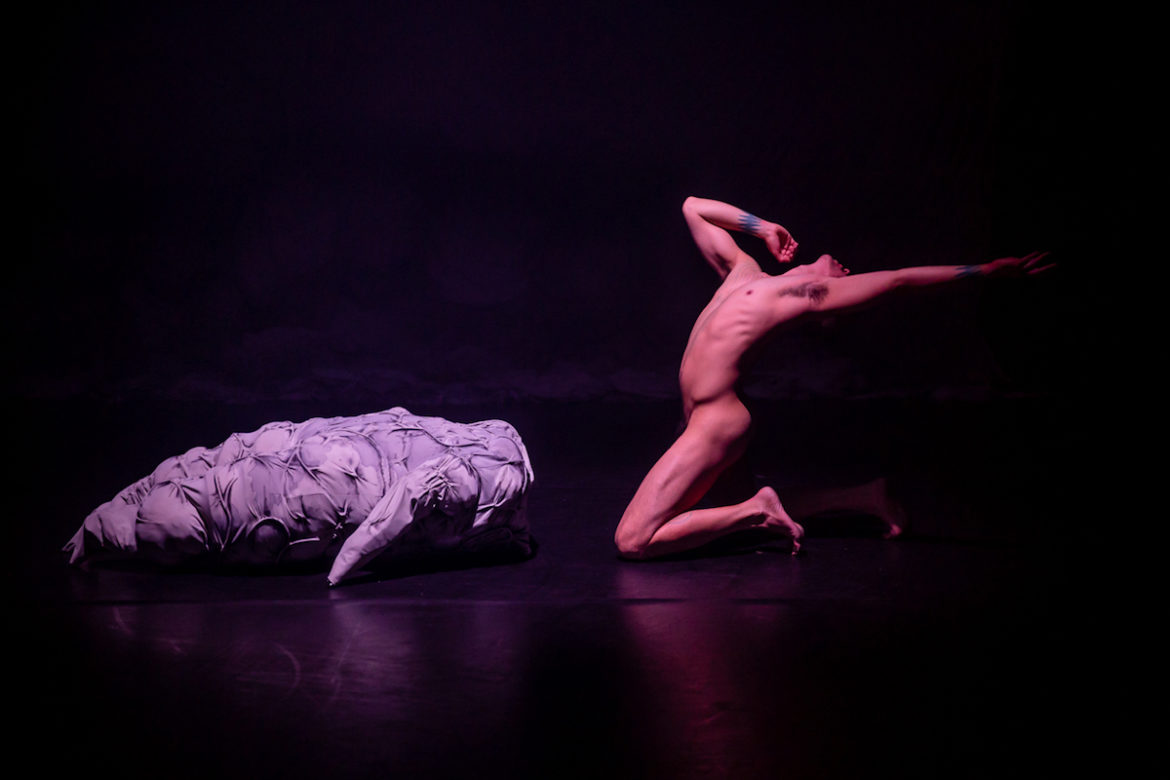Alison Croggon reviews Justin Shoulder’s visionary spectacle of the post-human, Carrion.
Justin Shoulder is a fascinating artist. His spectacular work grew out of the performance art traditions of Sydney’s queer club scene, incorporating aspects of his own heritage of Filipino myth and performance. The result is an unclassifiable amalgam of performance art, dance, visual art, puppetry and theatre.
At the core of his unsettling and strangely tender work Carrion, now on at Arts House, is an abiding question: what does it mean to be human? Like all simple questions, the answers, if there are any, are far from simple, and Shoulder’s visionary evocation of post-human possibilities opens all sorts of speculations.
The show opens with something like a tardigrade (an order of creature known more colloquially as water bears or moss piglets) or, alternatively, a kind of bivalve that, as we watch, grows human legs as it struggles out of its outer skin, like a crustacean, to reveal a naked man. A dancer.
He carefully dresses himself, transforming before our eyes into a masked creature with bones on the outside of his skin, at once insectile and birdlike. Around him is a jungle of mechanical parrots that imitate speech – I see you! – in between their recorded whistles. He makes bird noises: is he trying to speak to them? Is he simply curious? And then he’s a giant pulsating polyp, or perhaps a partially sentient intestine, that grows a human face. Then he’s the masked bird-insect-human again, bereft of words, at once sinister and innocent. Hungry. Predatory.
Carrion’s unsettling post-apocalyptic air expresses the urgency of the present moment. And its hallucinogenic series of images is a reminder that carbon-based life as we know it is far stranger than we generally are willing to realise. Shoulder’s performance rebukes the all-too-human tendency to assume, despite all evidence to the contrary, that now represents the culmination of an inexorable progress towards perfection.
Who and what human beings are is a series of chemical accidents, refined over epochs, but we generally prefer to believe we are here with transcendent purpose. Given what we’ve done to the ecosystems on which we depend for survival, there’s a good argument that the purpose of homo sapiens is to be a catastrophe, not only for ourselves, but for the rest of the life on the planet. We’re well into the Holocene Extinction, the sixth major extinction event in the history of the planet. (The last one was the Cretaceous–Paleogene, which ended the Cretaceous period, 66 million years ago).
There’s nothing inevitable, after all, about “progress”, whether it’s historical or evolutionary. Anyone who talks about history “judging” us is really being nostalgic for an omniscient God who Sees All, a kind of transcendent justice that only exists in our imagination. “History” won’t judge us, although some people in the future, if any are left, may well do so. But there’s nothing inevitable about that, either: as a species we’re also very good at forgetting, which perhaps is part of our survival package: memory can be a crippling trauma.
We’re also very good at making myths. This, like most human capacities, is both marvellous and catastrophic: myth-making is one of the ways we make narrative sense of the worlds we inhabit, and often how we learn to see more clearly. But some of our most pernicious myths, the myths that are undoing our very existence, are invisible.
Money, for example, is surely the most powerful fetish in contemporary society. It has become way more than an abstraction that facilitates barter: it’s a transcendent truth, an overarching good that trumps every other consideration. And the myth that Man is made in God’s image persists beneath almost all our social relationships, religious or not: it anoints our exploitative treatment of other species and the ecologies on which they depend, and underlies the exclusion from the category of humanity all those lumped under “other”. Those who are not made in the image of God are, by definition, not human.
Shoulder’s post-human vision opens up the otherness of life itself, which is the source of its unsettling tenderness, a sense of innocence. We watch Shoulder’s creatures going through the strange agonies of becoming, a human face or limb emerging and vanishing. Each struggles towards its own actualisation, before transforming into yet another version of itself. Yet, however strange they are, these beings remain intimately recognisable. He literalises how technologies and tools become incorporated into our bodies. Our very interiors – our guts, our bones – are exposed and autonomous, mysterious and familiar at once.
Shoulder’s performance has an astonishing intensity, a sense of ritual and precision of movement that reaches deep into the subconscious. I found myself simultaneously aware of the artifice of his creations – the illusions don’t depend on our not knowing how they’re done – and utterly seduced by their compelling realities. It’s a remarkable show.
Carrion, created and performed by Justin Shoulder, co-choreographed by Victoria Hunt. Music composed by Corin Ileto, costumes and set by Matthew Stegh and Justin Shoulder, lighting design by Benjamin Cisterne. Arts House Melbourne until June 30. Bookings
Contains nudity, smoke effects and loud music. Arts House is wheelchair accessible.
Auslan interpreted performance: 8pm, Saturday June 30.

